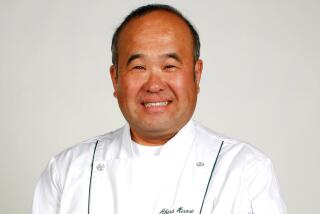Kodo--Taking Risks and Making Changes
- Share via
TOKYO — “Bringing on the big drum at the beginning of the program is scary. It’s a big risk,” says Yoshiaki Oi, the new director of Kodo. “The big drum is our trick, our treasure. We’ve always kept it until the end.”
By now, Los Angeles is familiar with Kodo, the Japanese taiko performance group that annually tours America. But audiences who attend this year’s performances at UCLA’s Royce Hall on Feb. 5 and 7--part of Kodo’s One Earth Tour ‘88--will notice certain changes. These changes signal a turning point in Kodo’s 16-year history.
Last year, on Jan. 1, Toshio Kawauchi, Kodo’s artistic director since 1981, died in a snorkeling accident. Ten days later, the company left on its American tour.
“We had no time to think about his death. It wasn’t until we returned in the spring that we dealt with it emotionally. Then things started to happen,” says Oi.
Kawauchi was an all-powerful director in this theoretically democratic company. He oversaw everything, from all artistic decisions to finances and management. So it was a big shock when it was discovered, after his death, that he kept no records on paper.
“Everything was in his head,” Oi says. “After he died, we had to start from the beginning.”
Oi is Kodo’s senior member, and one of the few to drum the o-daiko , or big drum (it weighs roughly 700 pounds), which is the company’s symbol. Married to an ex-member of Kodo and the father of three children, he had stopped performing the year before to teach the company’s apprentices. He was the group’s immediate and unanimous choice to succeed Kawauchi.
A tall, taciturn man, Oi turned over administrative and management duties to his staff. And he has already made his mark on the company, intentionally revamping the performing style. Besides new and varied pieces in the repertory, audiences will notice a subtle but distinct change in the way the evening is structured.
“Before, it was like dominoes. It began and then was a chain reaction, building towards the end,” Oi says. While Kawauchi personally directed each separate piece, Oi--clearly at ease delegating authority--has appointed a leader for each one. “Now, each piece is independent and self-contained, with its own dynamic,” he says.
Departing from a tried-and-true formula is especially risky for Kodo. The company receives neither government nor corporate support (funding for arts is a new concept in recently affluent Japan) and, besides just keeping the company clothed and fed, Oi’s new management staff must raise money for Kodo’s most important project to date: a new home.
Since 1971, the members have lived communally on the ruggedly beautiful island of Sado in the Japan Sea. Recently, they purchased 25 acres of forested land and are building new facilities to house not only Kodo’s company members and their families (a few years ago, Kodo almost doubled its membership to 31) but an increasing number of visitors.
There will be a performance center, as well. Two traditional Japanese farmhouses, slated for the wrecking ball, were bought by Kodo and transported to Sado for Kodo Village.
“Sado is the most beautiful place in the world,” says Oi, who, along with Kawauchi, was part of the original group to arrive there in 1971. That was a time of student political revolution in Japan, and Sado natives were very distrustful of these young men and women living communally in an old schoolhouse.
“Eventually, we established good relations through our contact with local merchants. And children came to play on the school grounds,” says Oi. Now, the population of Sado--mostly farmers and fishermen--is declining as young people leave and go to Honshu (the main island) to study and work. So, the town of Ogi, where they are moving, is welcoming them.
Summer is traditionally festival season in Japan, and to celebrate the opening of Kodo Village, the company is producing the first annual Earth Celebration, from Aug. 15-22.
“We have gained so much from the island, that we sincerely want to give something back to it. So we invited great musicians from around the world,” Oi says. These include, among others, jazz drummer Elvin Jones, jazz pianist Yamashita Yosuke and Les Tambours du Burundi. Besides concerts, there will be lectures, workshops and exhibitions.
All this, plus a demanding touring schedule, is keeping Kodo very busy these days, and it hardly has time to train anymore. Years ago, it was as famous for an incredibly Spartan regimen--running a marathon twice each day--as for its drumming.
Today, when they are on Sado, the members have scaled down to 10 kilometers in the morning. And the new director admits that members, while well-disciplined, are far from ascetic fanatics.
“There are no rules now. It’s up to the individual,” Oi says. “We’re not demon drummers anymore. We’re human beings. We’re Kodo.”
More to Read
The biggest entertainment stories
Get our big stories about Hollywood, film, television, music, arts, culture and more right in your inbox as soon as they publish.
You may occasionally receive promotional content from the Los Angeles Times.










